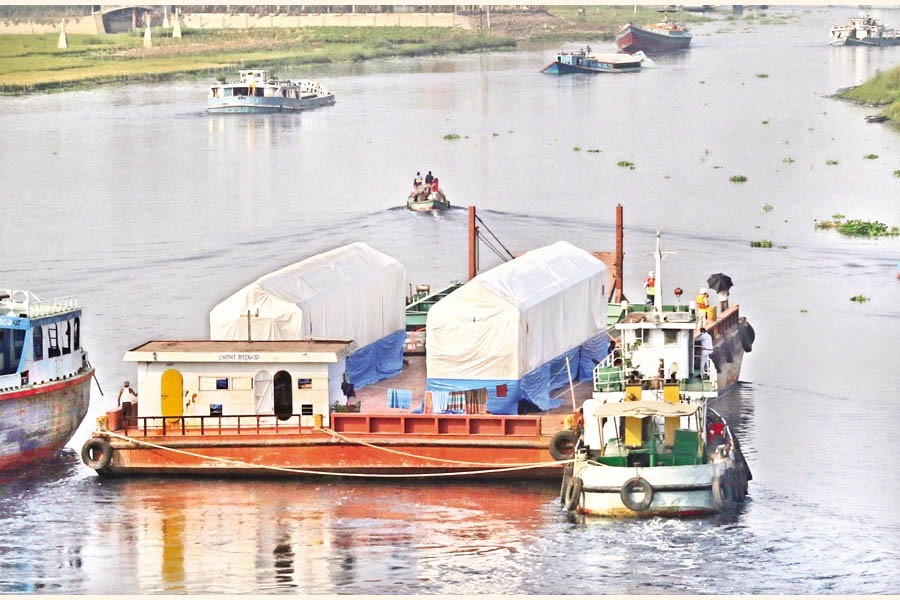Giving life to the rivers encircling the capital city-a couple of which rendered almost lifeless with many of their channels filled up and grabbed-is a topic that seemingly fell to deaf years for decades. Lately, there is a move at the initiative of the highest authority to prepare a 20-year master plan to revive the long neglected Dhaka rivers. The plan aims at returning life to the rivers surrounding the capital by preventing pollution, ridding the rivers of illegal occupation, and adding long-term beautification along the river banks. The authorities also plan to generate electricity from river waste and take steps to close the sources of river pollution. The draft of the master plan which also aims to increase the navigability of rivers alongside preventing river pollution and encroachment is reportedly in its final stage. The draft plan, according to official sources, is reviewing the current situation of the tributaries, rivers, and canals of Dhaka and the surrounding districts. The status quo will be developed in four steps, through a 1-year crash programme, a short-term plan of three years, a mid-term plan of five years, and a long term plan of 10 years.
According to the Bangladesh Inland Water Transport Authority (BIWTA), around 113 acres of illegally occupied land belonging to rivers has already been regained as part of the process. In the first phase, 10,000 boundary pillars, 52-km walkways, three eco parks and 19 jetties will be constructed on the banks of the rivers freed by the eviction drive. The project will cost Tk 8.0 billion in the initial stage as per the draft, added the sources. Besides, BIWTA sent a revised Regional Development and Protection Programme (RDPP) to the Ministry of Shipping with a few amendments from the initial one, with the aim of building an efficient shipping system around Dhaka.
The five main rivers that are at the focal point of the master plan - Buriganga, Turag, Balu, Dhaleswary and Sitalakhya, have for long been subjected to reckless human abuses. While pollution from nearby factories caused by liquid and solid waste has made the river waters toxic and absolutely unusable, land grabbing has weakened the water flow narrowing the channels, even reducing them into tiny muddy trickles. It is clearly the lack or absence of control for decades by the relevant bodies that came to the advantage of the wrongdoers. Neither the BIWTA nor the Department of Environment (DoE) opted for strong actions. Occasional and half-hearted efforts by BIWTA to reclaim the river banks from illegal occupants did not produce any positive result until the latest round of actions around a year ago that did see a considerable change in the state of things-especially in prevailing over the influence of a number of powerful land grabbers and freeing vast swathes of river banks. So far as reclaiming occupied lands on the river banks is concerned, it is expected that BIWTA would eventually succeed in its mission. But the important task for the organisation is to improve navigability. Navigability in some of the aforementioned rivers is seriously at stake. Due to earth filling by grabbers, some of the vital river channels are no longer in existence which must be restored to their original state. Besides, improving overall navigability, particularly in the lean season, is extremely important. It may be noted that because of lack of navigability, the much drummed up water bus service could not succeed. There are of course other reasons for the failure of the water bus service, but had navigability been up to the satisfactory level, things might not have turned that bad. In this context it may be pertinent to mention that there are many low-height bridges over some of the river channels that obstruct movement of river transports. Construction of these bridges should have been done as per BIWTA guidelines, which were not followed. Now, while improving navigability, the issue of knocking down some of the bridges may be necessary. The masterplan should include measures to do the needful.
Another equally important issue is stopping factory waste from polluting the rivers. It is not understood how the master plan can be helpful in doing so. It is well known that of all the waste flowing into the rivers, it is the leather waste from tanneries that is most ruinous. Before shifting of the tanneries from Hazaribagh to Savar, it was the Buriganga that had its waters spoiled, and now after the shifting, it is the Dhaleshwary that is taking the toll of untreated leather waste. The central effluent treatment plant (CETP) at the Savar leather estate is nonfunctional as of now, and chances that it will be soon, are reportedly very slim. The same goes with many waste generating factories that too do not have properly functioning waste treatment plants and discharge their liquid and solid waste into the rivers. Given the state of things, one cannot hope to see the DoE mending the wrongs. As the relevant state authority, it can oversee and take penal actions. But unless the waste treatment plants are in place including the CETP at Savar leather estate, going for penal actions makes no sense.
So, unless pollution is stopped, the master plan will deliver only partly. Since the 20-year plan will be worked out in phases, it is in the interest of all that critical issues like water pollution is addressed once and for all. This can ensure retuning life to the dying rivers.


